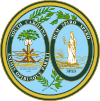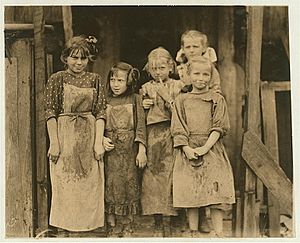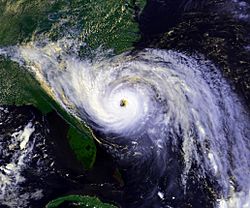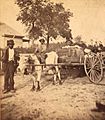South Carolina facts for kids
Quick facts for kids
South Carolina
|
|||
|---|---|---|---|
|
|||
| Nickname(s):
The Palmetto State
|
|||
| Motto(s):
Dum spiro spero
"While I breathe, I hope" Animis opibusque parati "Prepared in mind and resources" |
|||
| Anthem: "Carolina" "South Carolina on my Mind" |
|||
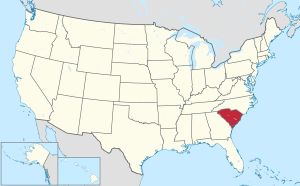
Location of South Carolina within the United States
|
|||
| Country | United States | ||
| Before statehood | Province of South Carolina | ||
| Admitted to the Union | May 23, 1788 (8th state) | ||
| Capital | Columbia | ||
| Largest city | Charleston | ||
| Largest county or equivalent | Greenville | ||
| Largest metro and urban areas | Greenville (combined and metro) Columbia (urban) |
||
| Legislature | General Assembly | ||
| • Upper house | Senate | ||
| • Lower house | House of Representatives | ||
| Judiciary | South Carolina Supreme Court | ||
| U.S. senators | Lindsey Graham (R) Tim Scott (R) |
||
| U.S. House delegation | 6 Republicans 1 Democrat (list) |
||
| Area | |||
| • Total | 32,020.49 sq mi (82,932.7 km2) | ||
| • Land | 30,060.70 sq mi (77,856.9 km2) | ||
| • Water | 1,959.79 sq mi (5,075.8 km2) 6.12% | ||
| Area rank | 40th | ||
| Dimensions | |||
| • Length | 260 mi (420 km) | ||
| • Width | 200 mi (320 km) | ||
| Elevation | 350 ft (110 m) | ||
| Highest elevation | 3,560 ft (1,085 m) | ||
| Lowest elevation
(Atlantic Ocean)
|
0 ft (0 m) | ||
| Population
(2024)
|
|||
| • Total | |||
| • Rank | 23rd | ||
| • Density | 170.27/sq mi (65.74/km2) | ||
| • Density rank | 19th | ||
| • Median household income | $67,800 (2023) | ||
| • Income rank | 41st | ||
| Demonym(s) | South Carolinian | ||
| Language | |||
| • Official language | English | ||
| • Spoken language | |||
| Time zone | UTC−05:00 (Eastern) | ||
| • Summer (DST) | UTC−04:00 (EDT) | ||
| USPS abbreviation |
SC
|
||
| ISO 3166 code | US-SC | ||
| Traditional abbreviation | S.C. | ||
| Latitude | 32°02′ N to 35°13′ N | ||
| Longitude | 78°32′ W to 83°21′ W | ||
| Dance | Carolina shag |
|---|---|
| Bird | Carolina Wren |
| Fish | Striped bass |
| Flower | Yellow jessamine |
| Tree | Sabal palmetto |
| Insect | Carolina mantis |
South Carolina ( KARR-ə-LY-nə) is a state in the Southeastern region of the United States. It borders North Carolina to the north and northeast, the Atlantic Ocean to the southeast, and Georgia to the west and south across the Savannah River. Along with North Carolina, it makes up the Carolinas region of the East Coast. South Carolina is the 40th-largest and 23rd-most populous U.S. state with a recorded population of 5,118,425 according to the 2020 census. In As of 2019[update], its GDP was $213.45 billion. South Carolina is composed of 46 counties. The capital is Columbia with a population of 136,632 in 2020; while its most populous city is Charleston with a 2020 population of 150,227. The Greenville-Spartanburg-Anderson, SC Combined Statistical Area is the most populous combined metropolitan area in the state, with an estimated 2023 population of 1,590,636.
South Carolina was named in honor of King Charles I of England, who first formed the English colony, with Carolus being Latin for "Charles". In 1712 the Province of South Carolina was formed. One of the original Thirteen Colonies, South Carolina became a royal colony in 1719. During the American Revolutionary War, South Carolina was the site of major activity among the American colonies, with more than 200 battles and skirmishes fought within the state. South Carolina became the eighth state to ratify the U.S. Constitution on May 23, 1788. A slave state, it was the first state to vote in favor of secession from the Union on December 20, 1860. After the American Civil War, it was readmitted to the Union on July 9, 1868.
During the early-to-mid 20th century, the state started to see economic progress as many textile mills and factories were built across the state. The civil rights movement of the mid-20th century helped end segregation and legal discrimination policies within the state. Economic diversification in South Carolina continued to pick up speed during and in the ensuing decades after World War II. In the early 21st century, South Carolina's economy is based on industries such as aerospace, agribusiness, automotive manufacturing, and tourism.
Within South Carolina from east to west are three main geographic regions, the Atlantic coastal plain, the Piedmont, and the Blue Ridge Mountains in the northwestern corner of Upstate South Carolina. South Carolina has primarily a humid subtropical climate, with hot, humid summers and mild winters. Areas in the Upstate have a subtropical highland climate. Along South Carolina's eastern coastal plain are many salt marshes and estuaries. South Carolina's southeastern Lowcountry contains portions of the Sea Islands, a chain of barrier islands along the Atlantic Ocean.
Contents
History
Precolonial period
There is evidence of human activity in the area about 12000 years ago. At the time Europeans arrived, marking the end of the Pre-Columbian era around 1600, there were many separate Native American tribes, the largest being the Cherokee, and the Catawba, and the total population being up to 20000
Up the rivers of the eastern coastal plain lived about a dozen tribes of Siouan background. Along the Savannah River were the Apalachee, Yuchi, and the Yamasee. Further west were the Cherokee, and along the Catawba River, the Catawba. These tribes were village-dwellers, relying on agriculture as their primary food source. The Cherokee lived in wattle and daub houses made with wood and clay, roofed with wood or thatched grass.
About a dozen separate small tribes summered on the coast harvesting oysters and fish, and cultivating corn, peas and beans. Travelling inland as much as 50 miles (80 km) mostly by canoe, they wintered on the coastal plain, hunting deer and gathering nuts and fruit. The names of these tribes survive in place names like Edisto Island, Kiawah Island, and the Ashepoo River.
Colonization
The Spanish were the first Europeans in the area, in 1521, founding San Miguel de Gualdape, the first European settlement in what is now mainland USA five years later. Established with 500 settlers, it was abandoned within a year by 150 survivors. In 1562 French settlers established a settlement at what is now the Charlesfort-Santa Elena archaeological site on Parris Island but abandoned after a fire destroyed their supplies. Three years later the Spanish built a fort on the same site, but withdrew following hostilities with the English navy.
In 1629, King Charles I of England established the Province of Carolina an area covering what is now South and North Carolina, Georgia and Tennessee. In the 1670s, English planters from the Barbados established themselves near what is now Charleston.
Settlers built rice plantations in the South Carolina Lowcountry, east of the Atlantic Seaboard fall line. Settlers came from all over Europe. Plantation labor was done by African slaves who formed the majority of the population by 1720. Another cash crop was the Indigo plant, a plant source of blue dye, developed by Eliza Lucas.
Meanwhile, in Upstate South Carolina, west of the Fall Line, was settled by small farmers and traders, who displaced Native American tribes westward. Colonists overthrew the proprietors' (absentee English landowners) rule, seeing more direct representation. In 1719, the colony was officially made a crown colony. In 1729 North Carolina was split off into a separate colony.
Southern Carolina prospered from the fertility of the Low Country and the harbors, such as that at Charleston. It allowed religious toleration, encouraging Settlements spread, and trade in deerskin, lumber, and beef thrived. Rice cultivation was developed on a large scale.
By the second half of the 1700s South Carolina was one of the richest of what were about to become the Thirteen Colonies.
The American Revolution
On March 26, 1776, the colony adopted the Constitution of South Carolina, electing John Rutledge as the state's first president. In February, 1778, South Carolina became the first state to ratify the Articles of Confederation, the initial governing document of the United States, and in May 1788, South Carolina ratified the United States Constitution, becoming the eighth state to enter the union.
During the American Revolutionary War (1775–1783), about a third of combat action took place in South Carolina, more than in any other state. Inhabitants of the state endured being invaded by English forces and an ongoing civil war between loyalists an partisans that devastated the backcountry. It is estimated that 25,000 slaves (30% of those in South Carolina) fled, migrated or died during the war.
Antebellum
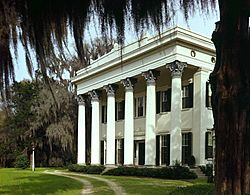
In the Antebellum period (before the Civil War) the state's economy and population grew.
Cotton became an important crop after the invention of the cotton gin. While nominally democratic, from 1790 until 1865, wealthy male landowners were in control of South Carolina. For example, a man was not eligible to sit in the State House of Representatives unless he possessed an estate of 500 acres of land and 10 Negroes, or at least 150 pounds sterling.
Columbia, the new state capital was founded in the center of the state, and the State Legislature first met there in 1790. The town grew after it was connected to Charleston by the Santee Canal in 1800, one of the first canals in the United States.
As dissatisfaction with the federal government grew, in the 1820s John C. Calhoun became a leading proponent of states' rights, limited government, nullification of the US Constitution, and free trade. In 1832, the Ordinance of Nullification declared federal tariff laws unconstitutional and not to be enforced in the state, leading to the Nullification Crisis. The federal Force Bill was enacted to use whatever military force necessary to enforce federal law in the state, bringing South Carolina back into line.
In the United States presidential election of 1860 voting was sharply divided, with the south voting for the Southern Democrats and the north for Abraham Lincoln's Republican Party. Lincoln was anti-slavery, did not acknowledge the right to secession, and would not yield federal property in Southern states. Southern secessionists believed Lincoln's election meant long-term doom for their slavery-based agrarian economy and social system.
Lincoln was elected present on 6 November 1860. The state House of Representatives immediately passed the "Resolution to Call the Election of Abraham Lincoln as U.S. President a Hostile Act, 9 November 1860", and within weeks South Carolina became the first state to declare secession from the US.
Civil War 1861–1865
On April 12, 1861, Confederate (southern) batteries began shelling the Union (federal, northern, or US) Fort Sumter in Charleston Harbor, after US troops refusal to leave the fort peacefully, and the American Civil War began. In November of that year the Union attacked Port Royal Sound and soon occupied Beaufort County and the neighboring Sea Islands. For the rest of the war this area served as a Union base and staging point for other operations. Whites abandoned their plantations, leaving behind about 10,000 slaves. Several Northern charities partnered with the federal government to help these people run the cotton farms themselves under the Port Royal Experiment. Workers were paid by the pound harvested and thus became the first former slaves freed by the Union forces to earn wages.
Although the state was not a major battleground, the war ruined the economy. Under conscription, all men aged 18–35 (later 45) were drafted for Confederate service. More than 60,000 served, and the state lost nearly one-third of the white male population of fighting age.
At the end of the war in early 1865, the troops of General William Tecumseh Sherman marched across the state devastating plantations and most of Columbia.
Reconstruction 1865–1877
After the war, South Carolina was restored to the United States during Reconstruction. Under presidential Reconstruction (1865–66), freedmen (former slaves) were given limited rights. Under Radical reconstruction (1867–1877), a Republican coalition of freedmen, carpetbaggers and scalawags was in control, supported by Union Army forces. They established public education, welfare institutions, and home rule for counties, expanding democracy.
On October 19, 1871 President Ulysses S. Grant suspended habeas corpus in nine South Carolina counties under the authority of the Ku Klux Klan Act. Led by Grant's Attorney General Amos T. Akerman, hundreds of Klansmen were arrested while 2000 Klansmen fled the state. This was done in order to suppress Klan violence against African-American and white voters in the South. In the mid to late 1870s, white Democrats used paramilitary groups such as the Red Shirts to intimidate and terrorize black voters. They regained political control of the state under conservative white "Redeemers" and pro-business Bourbon Democrats. In 1877, the federal government withdrew its troops as part of the Compromise of 1877 that ended Reconstruction.
1890's–
The state became a hotbed of racial and economic tensions during the Populist and Agrarian movements of the 1890s. A Republican-Populist biracial coalition took power away from White Democrats temporarily. To prevent that from happening again, Democrats gained passage of a new constitution in 1895 that effectively disfranchised almost all blacks and many poor whites by new requirements for poll taxes, residency, and literacy tests that dramatically reduced the voter rolls. By 1896, only 5,500 black voters remained on the voter registration rolls, although they constituted a majority of the state's population.
The 1900 census demonstrated the extent of disenfranchisement: the 782,509 African American citizens comprised more than 58% of the state's population, but they were essentially without any political representation in the Jim Crow society.
Early in the 20th century, South Carolina developed a thriving textile industry. The state also converted its agricultural base from cotton to more profitable crops; attracted large military bases through its powerful Democratic congressional delegation, part of the one-party South following disfranchisement of blacks at the turn of the century; and created tourism industries.
During the early part of the 20th century, thousands of African Americans left South Carolina and other southern states for jobs and better opportunities in northern, Midwestern and western cities. In total from 1910 to 1970, 6.5 million blacks left the South in the Great Migration. By 1930 South Carolina had a white majority for the first time since 1708.
The struggle of the Civil Rights Movement took place in South Carolina as well as other places in the South.
South Carolina was one of several states that initially rejected the Nineteenth Amendment (1920) giving women the right to vote. The South Carolina legislature later ratified the amendment on July 1, 1969.
Geography
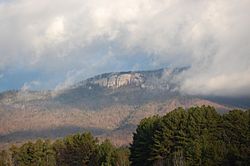
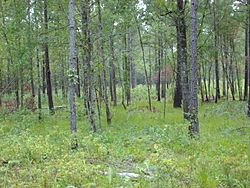
The state can be divided into three geographic areas. From east to west: the Atlantic coastal plain, the Piedmont, and the Blue Ridge Mountains. Locally, the coastal plain is referred to as the Low Country, and the other two regions as Up Country. The Atlantic Coastal Plain makes up two thirds of the state. Its eastern border is the Sea Islands, a chain of tidal and barrier islands. The border between the low country and the up country is defined by the Atlantic Seaboard fall line, which marks the limit of navigable rivers.
The state's coastline contains many salt marshes and estuaries, as well as natural ports such as Georgetown and Charleston. An unusual feature of the coastal plain is a large number of Carolina bays, the origins of which are uncertain. The bays tend to be oval, lining up in a northwest to southeast orientation. The terrain is flat and the soil is composed entirely of recent sediments such as sand, silt, and clay. Areas with better drainage make excellent farmland, though some land is swampy. The natural areas of the coastal plain are part of the Middle Atlantic coastal forests ecoregion.
Just west of the coastal plain is the Sandhills region. The Sandhills are remnants of coastal dunes from a time when the land was sunken or the oceans were higher.
The Upstate region contains the roots of an ancient, eroded mountain chain. It is generally hilly, with thin, stony clay soils, and contains few areas suitable for farming. Much of the Piedmont was once farmed. Due to the changing economics of farming, much of the land is now reforested in Loblolly pine for the lumber industry. These forests are part of the Southeastern mixed forests ecoregion. At the southeastern edge of the Piedmont is the fall line, where rivers drop to the coastal plain. The fall line was an important early source of water power. Mills built to harness this resource encouraged the growth of several cities, including the capital, Columbia. The larger rivers are navigable up to the fall line, providing a trade route for mill towns.
The northwestern part of the Piedmont is also known as the Foothills. The Cherokee Parkway is a scenic driving route through this area. This is where Table Rock State Park is located.
Highest in elevation is the Blue Ridge Region, containing an escarpment of the Blue Ridge Mountains, which continue into North Carolina and Georgia, as part of the southern Appalachian Mountains. Sassafras Mountain, South Carolina's highest point at 3,560 feet (1,090 m), is located in this area. Also located in this area is Caesars Head State Park. The environment here is that of the Appalachian-Blue Ridge forests ecoregion. The Chattooga River, located on the border between South Carolina and Georgia, is a favorite whitewater rafting destination.
Lakes

South Carolina has several major lakes covering over 683 square miles (1,770 km2). The following are the lakes listed by size.
- Lake Marion 110,000 acres (450 km2)
- Lake Strom Thurmond (also known as Clarks Hill Lake) 71,100 acres (290 km2)
- Lake Moultrie 60,000 acres (240 km2)
- Lake Hartwell 56,000 acres (230 km2)
- Lake Murray 50,000 acres (200 km2)
- Russell Lake 26,650 acres (110 km2)
- Lake Keowee 18,372 acres (70 km2)
- Lake Wylie 13,400 acres (50 km2)
- Lake Wateree 13,250 acres (50 km2)
- Lake Greenwood 11,400 acres (50 km2)
- Lake Jocassee 7,500 acres (30 km2)
- Lake Bowen
Earthquakes
Earthquakes in South Carolina demonstrate the greatest frequency along the central coastline of the state, in the Charleston area. South Carolina averages 10–15 earthquakes a year below magnitude 3 (FEMA). The Charleston Earthquake of 1886 was the largest quake ever to hit the Southeastern United States. This 7.2 magnitude earthquake killed 60 people and destroyed much of the city. Faults in this region are difficult to study at the surface due to thick sedimentation on top of them. Many of the ancient faults are within plates rather than along plate boundaries.
Climate
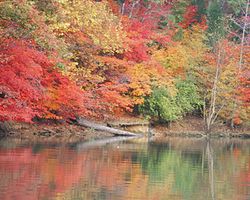
South Carolina has a humid subtropical climate, although high-elevation areas in the Upstate area have fewer subtropical characteristics than areas on the Atlantic coastline. In the summer, South Carolina is hot and humid, with daytime temperatures averaging between 86–93 °F (30–34 °C) in most of the state and overnight lows averaging 70–75 °F (21–24 °C) on the coast and from 66–73 °F (19–23 °C) inland. Winter temperatures are much less uniform in South Carolina.
Coastal areas of the state have very mild winters, with high temperatures approaching an average of 60 °F (16 °C) and overnight lows around 40 °F (5–8 °C). Inland, the average January overnight low is around 32 °F (0 °C) in Columbia and temperatures well below freezing in the Upstate. While precipitation is abundant the entire year in almost the entire state, the coast tends to have a slightly wetter summer, while inland, March tends to be the wettest month and winter the driest season, with November being the driest month. The highest recorded temperature is 113 °F (45 °C) in Johnston and Columbia on June 29, 2012, and the lowest recorded temperature is −19 °F (−28 °C) at Caesars Head on January 21, 1985.
Snowfall in South Carolina is somewhat uncommon in most of the state, while coastal areas receive less than an inch (2.5 cm) annually on average. It is not uncommon for areas along the coast (especially the southern coast) to receive no recordable snowfall in a given year. The interior receives a little more snow, although nowhere in the state averages more than 12 inches (30 cm) of snow annually. The mountains of extreme northwestern South Carolina tend to have the most substantial snow accumulation. Freezing rain and ice tend to be more common than snow in many areas of the state. Road bridges in South Carolina are commonly marked, "Bridge ices before road."
South Carolina is also prone to tropical cyclones and tornadoes. Two of the strongest hurricanes to strike South Carolina in recent history were Hurricane Hazel (1954) and Hurricane Hugo (1989).
Hurricanes and tropical cyclones
The state is occasionally affected by tropical cyclones. This is an annual concern during hurricane season, which lasts from June 1 to November 30. The peak time of vulnerability for the southeast Atlantic coast is from early August to early October, during the Cape Verde hurricane season. Memorable hurricanes to hit South Carolina include Hazel (1954) and Hugo (1989), both Category 4 hurricanes.
South Carolina averages around 50 days of thunderstorm activity a year. This is less than some of the states further south, and it is slightly less vulnerable to tornadoes than the states which border on the Gulf of Mexico. Some notable tornadoes have struck South Carolina, and the state averages around 14 tornadoes annually. Hail is common with many of the thunderstorms in the state, as there is often a marked contrast in temperature of warmer ground conditions compared to the cold air aloft.
Government
South Carolina's state government consists of executive, legislative, and judicial branches. The governor of South Carolina heads the executive branch; the South Carolina General Assembly heads the legislative branch; and the South Carolina Supreme Court heads the judicial branch.
Demographics
| Historical population | |||
|---|---|---|---|
| Census | Pop. | %± | |
| 1790 | 249,073 | — | |
| 1800 | 345,591 | 38.8% | |
| 1810 | 415,115 | 20.1% | |
| 1820 | 502,741 | 21.1% | |
| 1830 | 581,185 | 15.6% | |
| 1840 | 594,398 | 2.3% | |
| 1850 | 668,507 | 12.5% | |
| 1860 | 703,708 | 5.3% | |
| 1870 | 705,606 | 0.3% | |
| 1880 | 995,577 | 41.1% | |
| 1890 | 1,151,149 | 15.6% | |
| 1900 | 1,340,316 | 16.4% | |
| 1910 | 1,515,400 | 13.1% | |
| 1920 | 1,683,724 | 11.1% | |
| 1930 | 1,738,765 | 3.3% | |
| 1940 | 1,899,804 | 9.3% | |
| 1950 | 2,117,027 | 11.4% | |
| 1960 | 2,382,594 | 12.5% | |
| 1970 | 2,590,516 | 8.7% | |
| 1980 | 3,121,820 | 20.5% | |
| 1990 | 3,486,703 | 11.7% | |
| 2000 | 4,012,012 | 15.1% | |
| 2010 | 4,625,364 | 15.3% | |
| 2020 | 5,118,425 | 10.7% | |
| Source: 1910–2020 | |||
| Race and ethnicity | Alone | Total | ||
|---|---|---|---|---|
| White (non-Hispanic) | 62.1% |
|
65.5% |
|
| African American (non-Hispanic) | 24.8% |
|
26.3% |
|
| Hispanic or Latino | — | 6.9% |
|
|
| Asian | 1.7% |
|
2.3% |
|
| Native American | 0.3% |
|
1.8% |
|
| Pacific Islander | 0.1% |
|
0.1% |
|
| Other | 0.4% |
|
1.0% |
|
| Racial composition | 1990 | 2000 | 2010 |
|---|---|---|---|
| White | 69.0% | 67.2% | 66.2% |
| Black | 29.8% | 29.5% | 27.9% |
| Asian | 0.6% | 0.9% | 1.3% |
| Native American | 0.2% | 0.3% | 0.4% |
| Native Hawaiian and other Pacific Islander |
– | – | 0.1% |
| Two or more races | – | 1.0% | 1.7% |
The 2020 census determined the state had a population of 5,118,425. The United States Census Bureau estimates the population of South Carolina was 5,148,714 on July 1, 2019, an 11.31 percentage increase since the 2010 census.
As of the 2017 census estimate, the racial make up of the state is 68.5% White (63.8% non-Hispanic white), 27.3% Black or African American, 0.5% American Indian and Alaska Native, 1.7% Asian, 0.1% Native Hawaiian and other Pacific Islander, 1.9% from two or more races. 5.7% of the total population was of Hispanic or Latino origin of any race.
According to the United States Census Bureau, as of 2019, South Carolina had an estimated population of 5,148,714, which is an increase of 64,587 from the prior year and an increase of 523,350, or 11.31%, since the year 2010. Immigration from outside the United States resulted in a net increase of 36,401 people, and migration within the country produced a net increase of 115,084 people. According to the University of South Carolina's Arnold School of Public Health, Consortium for Latino Immigration Studies, South Carolina's foreign-born population grew faster than any other state between 2000 and 2005. South Carolina has banned sanctuary cities.
| African American |
| European American |
| Other |
Historical South Carolina racial breakdown of population
Religion
Religion in South Carolina Evangelical Protestant (35%) Mainline Protestant (16%) Historically Black Protestant (15%) Catholic (10%) Other Christian (2%) Other (2%) Unaffiliated ("none") (19%) Don't Know (1%)
According to the Association of Religion Data Archives (ARDA), in 2010, the largest religion is Christianity, of which the largest denominations were the Southern Baptist Convention with 913,763 adherents, the United Methodist Church with 274,111 adherents, and the Roman Catholic Church with 181,743 adherents. Fourth-largest is the African Methodist Episcopal Church with 564 congregations and 121,000 members and fifth-largest is the Presbyterian Church (USA) with 320 congregations and almost 100,000 members.
As of 2010, South Carolina is the American state with the highest per capita proportion of citizens who follow the Baháʼí Faith, with 17,559 adherents, making Baháʼí the second-largest religion in the state.
Economy and infrastructure

- Total employment (2016): 1,716,496
- Total employer establishments: 105,959
In 2019, South Carolina's GDP was $249.9 billion, making the state the 26th largest by GDP in the United States. According to the U.S. Bureau of Economic Analysis, South Carolina's gross state product (GSP) in was $97 billion in 1997 and $153 billion in 2007. Its per-capita real gross domestic product (GDP) in chained 2000 dollars was $26,772 in 1997 and $28,894 in 2007; which represented 85% of the $31,619 per-capita real GDP for the United States overall in 1997, and 76% of the $38,020 for the U.S. in 2007. The state debt in 2012 was calculated by one source to be $22.9bn, or $7,800 per taxpayer.
Industrial outputs include textile goods, chemical products, paper products, machinery, automobiles, automotive products and tourism. Major agricultural outputs of the state are tobacco, poultry, cotton, cattle, dairy products, soybeans, hay, rice, and swine. According to the Bureau of Labor Statistics, as of March 2012, South Carolina had 1,852,700 nonfarm jobs of which 12% are in manufacturing, 11.5% are in leisure and hospitality, 19% are in trade, transportation, and utilities, and 11.8% are in education and health services. The service sector accounts for 83.7% of the South Carolina economy.
Many large corporations have moved their locations to South Carolina. Boeing opened an aircraft manufacturing facility in Charleston in 2011, which serves as one of two final assembly sites for the 787 Dreamliner. South Carolina is a right-to-work state and many businesses utilize staffing agencies to temporarily fill positions. Domtar, in Rock Hill, used to be the only Fortune 500 company headquartered in South Carolina. The Fortune 1000 list includes SCANA, Sonoco Products and ScanSource.
South Carolina also benefits from foreign investment. There are 1,950 foreign-owned firms operating in South Carolina employing almost 135,000 people. Foreign Direct Investment (FDI) brought 1.06 billion dollars to the state economy in 2010. Since 1994, BMW has had a production facility in Spartanburg County near Greer and since 1996 the Zapp Group operates in Summerville near Charleston.
Media
There are 36 TV stations (including PBS affiliates) serving South Carolina with terrestrial, and some online streaming access. Markets in which the stations are located include Columbia, Florence, Allendale, Myrtle Beach, Greenville, Charleston, Conway, Beaufort, Hardeeville, Spartanburg, Greenwood, Anderson and Sumter.
Transportation
Roads
The state has the fourth largest state-maintained system in the country, consisting of 11 Interstates, numbered highways, state highways, and secondary roads, totalling approximately 41,500 miles.
On secondary roads, South Carolina uses a numbering system to keep track of all non-interstate and primary highways that the South Carolina Department of Transportation maintains. Secondary roads are numbered by the number of the county followed by a unique number for the particular road.
Rail
Passenger rail
Amtrak operates four passenger routes in South Carolina: the Crescent, the Palmetto, the Silver Meteor, and the Silver Star. The Crescent route serves the Upstate cities, the Silver Star serves the Midlands cities, and the Palmetto and Silver Meteor routes serve the lowcountry cities.
Station stops
| Station | Connections |
|---|---|
| Camden |
Silver Star
|
| North Charleston |
Palmetto
Silver Meteor
|
| Columbia |
Silver Star
|
| Clemson |
Crescent
|
| Denmark |
Silver Star
|
| Dillon |
Palmetto
|
| Florence |
Palmetto
Silver Meteor
|
| Greenville |
Crescent
|
| Kingstree |
Palmetto
Silver Meteor
|
| Spartanburg |
Crescent
|
| Yemassee |
Palmetto
Silver Meteor
|
Freight
CSX Transportation and Norfolk Southern are the only Class I railroad companies in South Carolina, as other freight companies in the state are short lines.
Major and regional airports
There are seven significant airports in South Carolina, all of which act as regional airport hubs. The busiest by passenger volume is Charleston International Airport. Just across the border in North Carolina is Charlotte/Douglas International Airport, the 30th busiest airport in the world, in terms of passengers.
- Columbia Metropolitan Airport – Columbia
- Charleston International Airport – North Charleston
- Greenville-Spartanburg International Airport – Greenville/Spartanburg
- Florence Regional Airport – Florence
- Myrtle Beach International Airport – Myrtle Beach
- Hilton Head Airport – Hilton Head Island/Beaufort
- Rock Hill/York County Airport – Rock Hill
Transportation
Road
The state has the fourth largest state-maintained system in the country, consisting of 11 Interstates, numbered highways, state highways, and secondary roads, totalling approximately 41,500 miles.
Rail
Passenger
Amtrak operates four passenger routes in South Carolina: the Crescent, the Palmetto, the Silver Meteor, and the Silver Star. The Crescent route serves the Upstate cities, the Silver Star serves the Midlands cities, and the Palmetto and Silver Meteor routes serve the low country cities.
Freight
CSX Transportation and Norfolk Southern are the only Class I railroad companies in South Carolina, as other freight companies in the state are short lines.
Major and regional airports
There are seven significant airports in South Carolina, all of which act as regional airport hubs. The busiest by passenger volume is Charleston International Airport. Just across the border in North Carolina is Charlotte/Douglas International Airport, the 30th busiest airport in the world, in terms of passengers.
Federal lands in South Carolina

- Charles Pinckney National Historic Site at Mt. Pleasant
- Congaree National Park in Hopkins
- Cowpens National Battlefield near Chesnee
- Fort Moultrie National Monument at Sullivan's Island
- Fort Sumter National Monument in Charleston Harbor
- Kings Mountain National Military Park at Blacksburg
- Ninety Six National Historic Site in Ninety Six
- Overmountain Victory National Historic Trail
- Fort Jackson near Columbia
- Joint Base Charleston near Charleston
- Shaw Air Force Base near Sumter
Gallery
-
Arcadia Plantation, circa 1893, Georgetown County
-
Beachcombers at Myrtle Beach photographed from the ninth floor of a resort hotel
-
Access to Fort Sumter in Charleston harbor, where the American Civil War began in 1861, requires a half-hour ferry ride each way.
-
An historic home on "The Battery", a neighborhood/park area in the Downtown historic district of the peninsula of Charleston, South Carolina.
-
Coastal towns and cities often have hurricane-resistant Live oaks overarching the streets in historic neighborhoods, such as these on East Bay Street, Georgetown.
-
Furman University bell tower near Greenville.
Education
As of 2010, South Carolina is one of three states that have not agreed to use competitive international math and language standards.
In 2014, the South Carolina Supreme Court ruled the state had failed to provide a "minimally adequate" education to children in all parts of the state as required by the state's constitution.
South Carolina has 1,144 K–12 schools in 85 school districts with an enrollment of 712,244 as of fall 2009. As of the 2008–2009 school year, South Carolina spent $9,450 per student which places it 31st in the country for per student spending.
In 2015, the national average SAT score was 1490 and the South Carolina average was 1442, 48 points lower than the national average.
South Carolina is the only state which owns and operates a statewide school bus system. As of December 2016, the state maintains a 5,582-bus fleet with the average vehicle in service being fifteen years old (the national average is six) having logged 236,000 miles. Half of the state's school buses are more than 15 years old and some are reportedly up to 30 years old. In 2017 in the budget proposal, Superintendent of Education Molly Spearman requested the state lease to purchase 1,000 buses to replace the most decrepit vehicles. An additional 175 buses could be purchased immediately through the State Treasurer's master lease program. On January 5, 2017, the U.S. Environmental Protection Agency awarded South Carolina more than $1.1 million to replace 57 school buses with new cleaner models through its Diesel Emissions Reduction Act program.
Institutions of higher education
South Carolina has diverse institutions from large state-funded research universities to small colleges that cultivate a liberal arts, religious or military tradition.
- The College of Charleston, founded in 1770 and chartered in 1785, is the oldest institution of higher learning in South Carolina, the 13th oldest in the United States, and the first municipal college in the country. The college is in company with the Colonial Colleges as one of the original and foundational institutions of higher education in the United States. Its founders include three signers of the United States Declaration of Independence and three signers of the United States Constitution. The college's historic campus, listed on the U.S. Department of the Interior's National Register of Historic Places, forms an integral part of Charleston's colonial-era urban center. The Graduate School of the College of Charleston offers a number of degree programs and coordinates support for its nationally recognized faculty research efforts.
- The University of South Carolina, in Columbia, is a flagship, public, co-educational, research university with seven satellite campuses. It was founded in 1801 as South Carolina College, and its original campus, The Horseshoe, is listed on the National Register of Historic Places. The university's main campus covers over 359 acres (1.5 km2) in the urban core less than one city block from the South Carolina State House. The University of South Carolina has around 35,000 students on the Columbia campus.
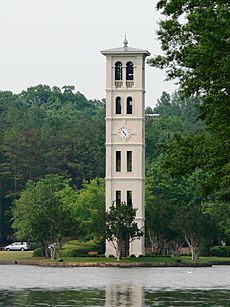
- Furman University is a private, coeducational, non-sectarian, liberal arts university in Greenville. Founded in 1826, Furman enrolls approximately 2,900 undergraduate and 500 graduate students. Furman is the largest private institution in South Carolina. The university is primarily focused on undergraduate education (only two departments, education and chemistry, offer graduate degrees).
- Erskine College is a private, coeducational liberal arts college in Due West, South Carolina. The college was founded in 1839 and is affiliated with the Associate Reformed Presbyterian Church, which maintains a theological seminary on the campus.
- The Citadel, The Military College of South Carolina is a state-supported, comprehensive college in Charleston. Founded in 1842, it is best known for its undergraduate Corps of Cadets military program for men and women, which combines academics, physical challenges and military discipline. In addition to the cadet program, the Citadel Graduate College offers evening certificate, undergraduate and graduate programs to civilians. The Citadel has 2,200 undergraduate cadets in its residential military program and 1,200 civilian students in the evening programs.
- Wofford College is a small liberal arts college in Spartanburg. Wofford was founded in 1854 with a bequest of $100,000 from the Rev. Benjamin Wofford (1780–1850), a Methodist minister and Spartanburg native who sought to create a college for "literary, classical, and scientific education in my native district of Spartanburg". It is one of the few four-year institutions in the southeastern United States founded before the American Civil War that operates on its original campus.
- Newberry College is a small liberal arts college in Newberry. Founded in 1856, Newberry is a co-educational, private liberal-arts college of the Evangelical Lutheran Church in America (ELCA) on a historic 90-acre (36 ha) campus in Newberry, South Carolina. It has roughly 1,110 students and a 14:1 student-teacher ratio. According to U.S. News & World Report's America's Best Colleges, Newberry College ranks among the nation's top colleges in the southern region.
- Claflin University, founded in 1869 by the American Missionary Association, is the oldest historically black college in the state. After the Democratic-dominated legislature closed the university in 1877, before passing a law to restrict admission to whites, it designated Claflin as the only state college for blacks.
- Lander University is a public liberal arts university in Greenwood. Lander was founded in 1872 as Willamston Female College. The school moved to Greenwood in 1904 and was renamed Lander College in honor of its founder, Samuel Lander. In 1973 Lander became part of the state's higher education system and is now a co-educational institution. The university is focused on undergraduate education and enrolls approximately 3,000 undergraduates.
- Presbyterian College (PC) is a private liberal arts college founded in 1880 in Clinton. Presbyterian College enrolls around 1000 undergraduate students and around 200 graduate students in its pharmacy school. In 2007, Washington Monthly ranked PC as the No. 1 Liberal Arts College in the nation.
- Winthrop University, founded in 1886 as an all-female teaching school in Rock Hill, became a co-ed institution in 1974. It is now a public university with an enrollment of just over 6,100 students. It is one of the fastest growing universities in the state, with several new academic and recreational buildings being added to the main campus in the past five years, as well as several more planned for the near future. The Richard W. Riley College of Education is still the school's most well-known area of study.
- Clemson University, founded in 1889, is a public, coeducational, land-grant research university in Clemson. It has more than 19,000 undergraduate students and 5,200 graduate students from all 50 states and from more than 70 countries. Clemson is also the home to the South Carolina Botanical Garden.
- North Greenville University, founded in 1891, is a comprehensive university in Tigerville. It is affiliated with South Carolina Baptist Convention and the Southern Baptist Convention, and is accredited by the Commission on Colleges of the Southern Association of Colleges and Schools. It has an enrollment of around 2,500 undergraduates.
- South Carolina State University, founded in 1896, is a historically black university in Orangeburg. SCSU has an enrollment of nearly 5,000, and offers undergraduate, graduate and post-graduate degrees. SCSU boasts the only Doctor of Education program in the state.
- Anderson University, founded in 1911, is a selective comprehensive university that offers bachelor's and master's degrees. It enrolls about 2,900 students.
- Webster University, founded in 1915 in St. Louis, MO, with five extended campuses in SC, offers undergraduate and graduate degrees.
- Bob Jones University, founded in 1927, is a private, non-denominational and conservative Christian liberal arts university with a 2019 total enrollment of 3,000. BJU offers more than 60 undergraduate majors and 70 graduate programs.
- Coastal Carolina University, founded in 1954, became an independent state-supported liberal arts university in 1993. The university enrolls approximately 10,500 students on its 307-acre (1.24 km2) campus in Conway, part of the Myrtle Beach metropolitan area. Baccalaureate programs are offered in 51 major fields of study, along with graduate programs in education, business administration (MBA), and coastal marine and wetland studies.
- Charleston Southern University, founded in 1969, is a liberal arts university, and is affiliated with the South Carolina Baptist Convention. Charleston Southern (CSU) is on 300 acres, formerly the site of a rice and indigo plantation, in the City of North Charleston one of South Carolina's largest accredited, independent universities, enrolling approximately 3,400 students.
- Francis Marion University, formerly Francis Marion College, is a state-supported liberal arts university near Florence, South Carolina. It was founded in 1970 and achieved university status in 1992.
Universities and colleges ranked by endowment, 2010
| State rank |
National rank |
Institution | Location | Public / private? | Endowment funds | Percentage change YOY |
|---|---|---|---|---|---|---|
| 1 | 142 | Furman University | Greenville | Private | $650,000,000 | 7.8% |
| 2 | 151 | University of South Carolina | Columbia & regional campuses |
Public | $625,186,000 | 6.0% |
| 3 | 153 | Clemson University | Clemson | Public | $623,200,000 | 9.5% |
| 4 | 236 | Medical University of South Carolina | Charleston | Public | $272,319,000 | 13.7% |
| 5 | 270 | The Citadel | Charleston | Public | $244,000,000 | 8.1% |
| 6 | 324 | Wofford College | Spartanburg | Private | $166,619,000 | 10.2% |
| 7 | 447 | Presbyterian College | Clinton | Private | $97,590,000 | 11.0% |
| 8 | 530 | Converse College | Spartanburg | Private | $78,240,004 | 6.4% |
| 9 | 782 | Winthrop University | Rock Hill | Public | $43,600,000 | 13.6% |
| 10 | 658 | Coker College | Hartsville | Private | $37,660,000 | 4.9% |
Images for kids
-
Map of French Florida, which included modern-day South Carolina
-
Pinnacle Mountain viewed from Caesars Head.
-
A map of the average annual precipitation in South Carolina
-
Fort Sumter National Monument, site of the first battle of the American Civil War, in Charleston.
-
A roller coaster in the South Carolina portion of Carowinds.
See also
 In Spanish: Carolina del Sur para niños
In Spanish: Carolina del Sur para niños



